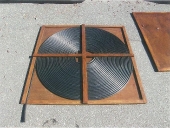I worked up a preliminary design of the most likely plan, and came up with a preliminary materials cost using materials from Home Depot & Amazon. Bottom line is it is too costly for my friend's small hobby greenhouse (200 square feet), but I will keep it in mind as I consider larger greenhouses. Here's a description of the design -
A small 6ft X 8 ft shed ($218 at Home Depot) will be used to house the RMH. The shed has a plywood floor over a frame. I would start with gravel on the ground, then lay the floor supports, but place concrete blocks directly on the gravel (between floor supports) to support the fire pit and HW tank. After finishing the construction of the RMH, I would add plywood for the remaining floor area, and then build the shed around the finished RMH.
I envision the fire pit built inside a 2 ft X 4 ft X 1 ft tall wooden box lined with foil. The fire pit is built with fire bricks and cob, with a 6" clay flue liner as feed tube, and a rectangular flue liner used for ash cleanout. The ash cleanout needs a door (TBD). The riser is made from 4" stove pipe inside an 8" stovepipe with clay and perlite mix sandwiched between them. The riser is long enough to reach the height of the top of a gas HW heater. At the top of the riser, the exhaust gas is routed into the top of the HW heater vent opening using two 90 degree elbows and a reducer to fit the 3" gas HW heater vent. Stone wool insulation is used to cover the riser and stove pipe sections. The "air inlet" opening at bottom of the gas HW heater (with burner removed) is connected to more stove pipe elbows to the final stove pipe that exits the shed.
Since the gas HW heater vent pipe is 3" I.D., a fan will likely be needed to keep sufficient airflow through the RMH combustion chamber. The simplest solution is to use a stovepipe auto-draft fan that fits a 4" stovepipe ($154 on Amazon) on the last section of stove pipe. An alternate (and possibly cheaper) idea is to put an airtight door on the feeder tube with a fan that blows air through the feeder tube.
A small reservoir water tank is placed above the height of the top of the gas HW heater for expansion and venting. This system is NOT pressurized (for safety). It is filled with non-toxic anti-freeze solution that will be pumped through radiators for heat transfer. Two 1/25 HP Grundfos HW circulation pumps are used - One to pump water through hydronic baseboard radiators in the greenhouse, and the other to pump HW through plastic (Pex) pipe submerged in the fish tank to heat the fish tank water.
My preliminary materials cost is over $1200, with the most expensive pieces being the shed, stovepipe fan, circulation pumps, then stove pipes and fittings and stone wool insulation.


